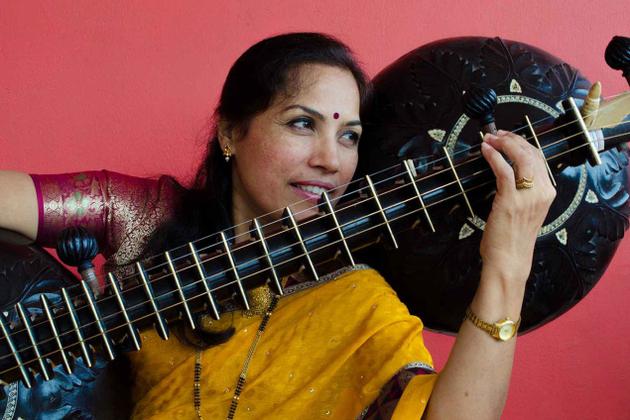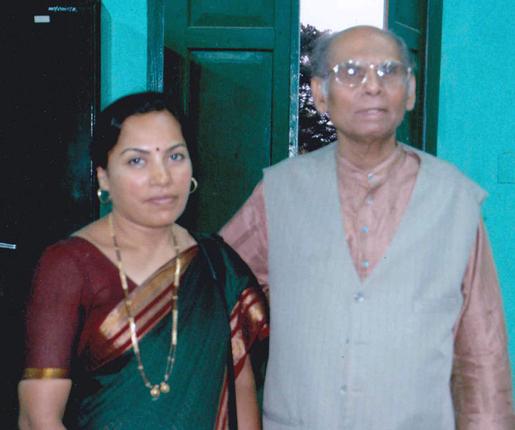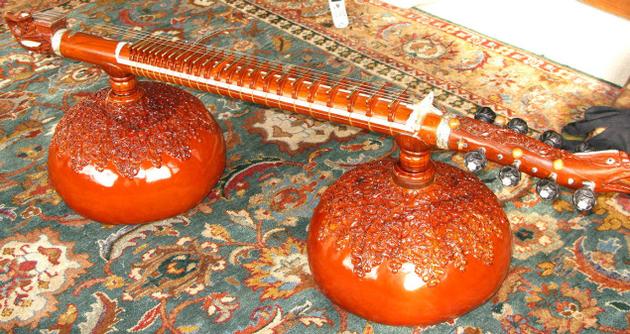Alwar, RAJASTHAN / NEW DELHI :
First impression: a small, wiry man with a gigantic string instrument.
Second impression: Once the frail man starts plucking the strings of the gigantic instrument and the melodious notes start flowing, you understand why Ustad Asad Ali Khan stands tall among today’s music maestros.
The only known living exponent of the rudra veena, Khansaab is probably one of the last of the musicians who combine traditional been techniques with an in-depth knowledge of the raagas.
“The rudra veena can execute all the subtleties of the human voice. Unlike the sitar and the sarod, it does not have tarap or resonance strings. Their absence allows the musicians to play shrutis or microtones, which are considered the ultimate in classical music. Iska awaz sabse buland hai.”
The Ustad should know. Trained by his father Ustad Sadiq Ali Khan, court musician of Alwar, Khansaab represents the legendary Jaipur beenkar gharana and traces his genius to his great grandfather Ustad Rajab Ali Khan. Being from the seventh generation of rudra veena players in the family, Ustad Asad Ali Khan’s relationship with this instrument of the gods is a passionate one. He challenges those who term the rudra veena as inflexible and a museum piece.
“These are excuses that people use to cover up their own inadequacies. Yes, it is a difficult instrument to play. But that is true of all classical music. It is not filmi music which you can learn in a few days,” he says emphatically.
Defending the rudra veena, Khan says, “The veena stands at the pinnacle of all stringed instruments. It is believed that the rudra veena was created by Lord Shiva who was inspired by Goddess Parvati. It was born out of his urge to create something that he could use to measure swaras and shrutis.”
But it is the man on this earth who has labelled this instrument “difficult”. “Isn’t the sitar difficult to play? Does not the sarod require years to master? Today’s musicians want the accolades easily without the hard work. It is they who have badmouthed the rudra veena,” he fumes.
For mastering the rudra veena you have to play by the rules, and Khan is unwilling to bend the rules. “The first requirement is to sit in the yogic vajrasana position. Unless you sit in that position, place the veena on the shoulder and use your breath as a modulator for notes, you cannot have the desired impact. The nuances of the notes will be lost if you change your posture. How many young people today can sit in that position for hours together?” he asks.
Raagas Mian ki malhar and Darbari Kanhada bring out the best from the rudra veena, feels the Ustad, who plays dhrupad in the Kandarbani style, which is one of the four ancient styles of Indian music.
Ustad Asad Ali is also against fusion music, which is seen as a way out to revive flagging interest in classical music. “Yeh hamaare shaan ki khilaaf hai. Fusion is not our job. We are not meant to compete with filmstars. In the drive to become commercially successful, we should not lose sight of our tradition and culture. Classical music and film/popular music have different positions in the world of music and that is the way to be,” he says.
Of course step-motherly treatment by the powers-that-be has also contributed to the decline of the rudra veena. “None of the five universities of music in the country teaches the rudra veena. Sadly, even I have taught the sitar in the Faculty of Music and Fine Arts in Delhi University for 17 years. The rudra veena is not taught there. Ultimately, the musician has to survive, and without a certificate, a rudra veena exponent will not get a job in any university,” he points out and laments, “Soon, we will have only foreigners playing the veena.” Currently, apart from a couple of Indian students, most of Khan’s disciples are from the West. His nephew Zaki Haider is also training under him, hoping to carry on the legacy.
“The government has to do more to preserve the fading tradition of the rudra veena. I have suggested that the recordings of Ustad Sadiq Ali Khan and other stalwarts lying with the Sangeet Natak Akademi should be marketed. I do not want any royalty, just make those recordings available before those tapes get destroyed. It may not mint millions, but millions of Indians will get to know their heritage,” he says. Carrying forward the task of telling the world about the instrument, the ustad is currently working on a book on the rudra veena, under a two-year fellowship given by the Ministry of Culture.
Unfortunately, it’s not just the rudra veena, but also the ustad who seems to have been forgotten by many. Despite being acclaimed for his musical virtuosity and for probably being the most well-known rudra veena player in the world, the country’s civilian honours have passed him by. “I do not want to lobby for such awards,” he says, but it can’t stop himself from adding that even harmonium players are feted by the public today while the rudra veena and rudra veena players are forgotten.
Gourds, frets and strings attached
SO we know that the rudra veena is rarely heard on the concert stage these days. That’s sad. But let’s get the vital statistics of this ornate instrument before it is forgotten. Musicians believe that the rudra veena is the ideal instrument for a dhrupad rendition because its sound has the same richness of overtones that the voice acquires with the practice of Nada Yoga.
This string instrument is different from the Saraswati veena in the way it is placed. The former rests against the shoulder while the latter is placed on the lap of the performer. Its basic structure is a bamboo mounted on two gourds with 19-24 frets fixed with bee’s wax. Additionally, there are four main and three side strings having a range of four to four and a half octaves. The gigantic dimensions also make it one of the heaviest instruments. At 10 kg, you can at best hope to balance the weight while sitting in the yogic vajrasana position.
If you want to be the proud owner of a rudra veena, you are going to be lighter by at least Rs 75,000. And you’ll also have to be patient. It takes at least a year to make a good rudra veena.
source: http://www.archive.financialexpress.com / The Financial Express / Home> Art & Enterainment / October 01st, 2006











